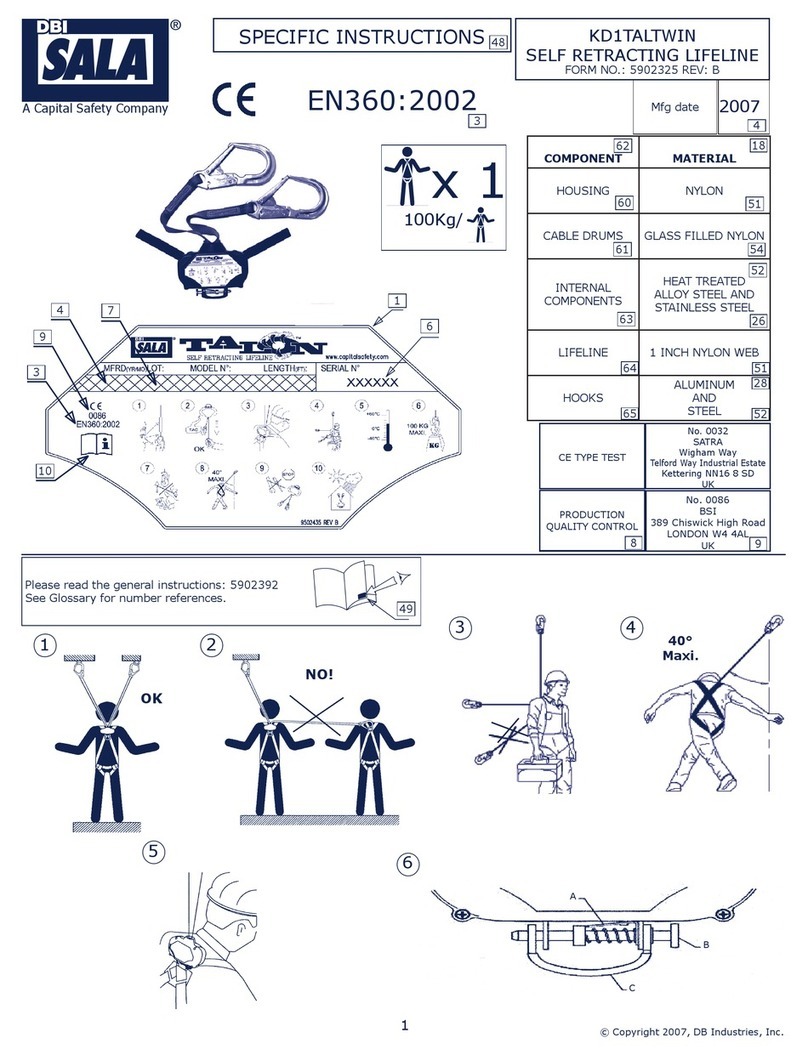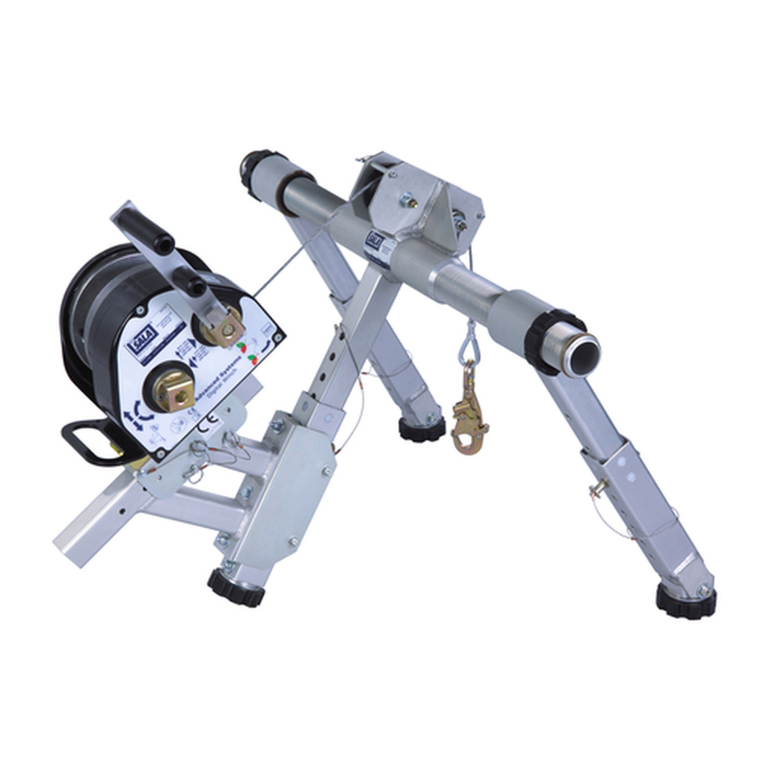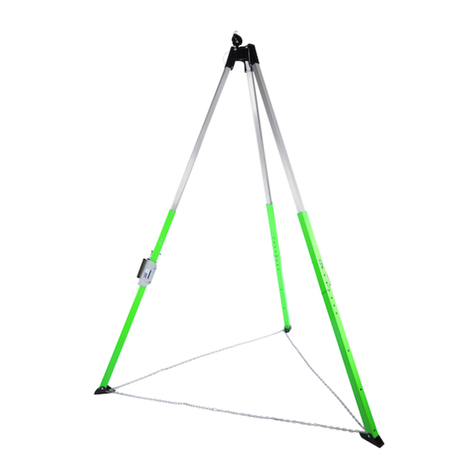
PROSER'ES
SHOCK
ABSORB''VG
LANYARD
Thismanualis intendedto meet the
Manufacturer's Instructions as required
by the following standards and should
be urcd as part of an employee
trainirygprcgram as required by OSHA:
Effi@Ne
ANSIz3se.l
@. csA225e.11
A Capital
Safety
Brand
WARNI NG: This
product ispart of a personal
restraint, work positioning, suspersion, or rescue
systefi. The user must read and follow the
manufacturet's instructions for each com
ponent
or part of lhe complete systen. Theseinstruc,tions
must beprovidedto the userof thisequipment.
Theuser must rcad and understand these
instructions or have then explained to them before
usin
g thi
s eq
ui
p
n enl. Manufacl
urer's irstrucliors
must be lollowed for propet useand maintenance
of this product. Alterations or misuse of fhis
ptoduct or failurc to follow instructions may rcsult
in serious injury or death.
I MPORTANT: tfyou
have
any
questions
on
the use,
care,
application,
or suitability
for useof
thisequipment,
corlacfCAPITALSAFETY-
I MPORTANT: Before
usingthisequipment
record the praduct identifiRtion information
(frcn the l.D. label) onto the inspection and
maintenance
log.
PURPOSE:PROTECTA
EnergyAberbing l€nyards
andEnergyAbsorbersareintended
to be usd aspart
of a personal
fallarrestsystem.
Appli€tigns indude
activitios
wherethereexists
the possibility
ofa fall.
LlMITATI ONS:Crnsiderthefollowing
appli€tion
limitations
beforeusingthisequipment:
GAPACITY:-Itlis
equipment
isfor us by oneperson
with acombinedweight(referto standard).
PHYSI
CALAND ENVIRONMENTAL
HAZARDS:
Useofthisequipmentinareascontaining
physi€l or
environmental
haurds may r€quire
that additional
precautions
betak6nto reducethe possibility
of
damageto thisequipment
or injuryto the user
Haards may include,but arenot limitedto: highheat,
strongor caustic
cflemicals,corrosive
environments,
thepossibility
ofeleclricdffent flowingthroughthis
equipment
whenworkingnesr highvoltage
pows
lineg,
explosiveor toxic
gases,
movingmachinery,
or
sharp
edges.Contad CAPITALSAFEW ifyouhave
anyquestions
about
theappli€tion ofthis€quipment
TRAINl NGi This
equipment
isintended
to be
installed
andusedby permnswho haveben
properly
trainedin itscorred applicationanduse.
APPLICABLE
STANDARDS:Referto nationalstandards
induding
ANSI2359.'1,CSA
2259.11 (Canada),
and
lo€1,
state,federal(OSHA
1910.66and1926.500),
and
CapitalSafetyrequirements
for moreinformation.
COMPATI
BlLlTYOFCOMPONENTS:
FROTECTA
equipmsntisdesignedfor u$ with PROTESrAapproved
@mponentsandsubsystemsonly.
Substitutions
mayieopardize
mmpatibilityof equipment
and
effeclthe safety
andreliability
of the system.
COMPATIBlLlTYOFCONNECrORS:
Conneclors
are@nsideredto becompatiblewith @nnecting
elements
whentheyhavebeendesignedto work
togetherin suchaway that theirsizesandshapes
donot causetheirgatemechanisms
to inadvertently
openregafdless
of hw they become
oriented.
@nneclors(hooks,
carabiners,and D-rings)must be
capableof ilpporting at least
5,000lbs.(22.2 kN).
Connedorsmust be compatiblewith the anchorag€
or othersystm mmponents. Donotus equipment
FORM
NO:5902281 RA/: E
that isnot mmpatible.Non-@mpatible
connectorsmay
unintentionallydisengage.Se Figure
1.Oonneclors
mustbe mmpatiblein size,shape,
andstrmgth.
MAKINGCONNECTIONS:
Onlyusesalf-tockingsnap
hooksandcarabiners.
Onlyuseconnedors
that are
suitableto aacf|
application.Ensur€
allmnnedions
aremmpatiblein size,shap€andstrength.
Ensure
all@nnec{ors
arefully dosodandlocked.
See
Figure
2 for inappropriate€nnec{ions. FROTESIA
snaphooksandcarabinersshould
notbemnnecied:
To
a D-ringto whichanothermnnectorisattachodand
in a mannerthat wouldresultina load
onthe qate.
NOTE: Llnless
equipped
with a 3600 tb. (16kN)
rated gates, larye throat-opening snap hooks
should not be connected to standatd sizeD-dngs
or sinilar objects which will result in a load on
the gate if the hoo4 or D-ring lwlsts or rotates.
Large throat snap hooks are desigred for useon
fixed structural elements such as rebar or soss
nembers that are not shaped in a way that can
capture the gate of the hook.
In afalse
sngagement,wh€refeatures
that protrude
from thosnap
hookor carabinsr
catchontheanchor,
andwithoutvisualconfirmationsegms
to befully
engaged
to the €nchor
pointor to each
other
Diresllytowebbing
or ropelanyard
or ti+back (unless
the manufadurer'sinstruclionsfor boththelanyard
andmnneclor sptrjfi€lly allows
sucfr
a @nnection).
Toanyobjed whidl isshapedor dimensioned
suchthat thesnap
hmk or carabingrs
willnot
doseand lock,or that roll-outcould
omr
ANCHORAGE
STRENGTH:Anchorages
slected for
per$nal fallarrestsystems
(FFAS)
shallhave
a strength
capable
of sustainingstaticloads,
appliedinthe diredions
psrmitledbylhe FFAS,of at least:(A) 3,600 tbs.
(16
kN) whm stificatim sists (reference ANSI 2359,1 for
certification deflnition), or (S) 5.000 lbs. (22,2 kN) in
the absenceof cstificaum, Whs mtre than one PFAS
isattacfied
to ananchorage,
ih€ anchorag€
strengths
set fortfi in (A) and (B) above must be multidied by
thenumberof PFASattachedto the anchorage.
From
OSHA
1926.500and 191ti.66:nncnoragesuseo
for attacfimentof PFqSshallbe independent
of any
anchorage
being
used
to support
or suspendplatforms,
andcapable
ofsupporting
at leasl5,000lbs.(22.2 kN)
perus6rattached,or bedesigned,
installed,
andusedas
partof a completePFAS,whichmaintains
a sfety fac{or
of at least two, and is superuisd by a qualified person.
WARNI NG: Da not altet or intentionally
nisue this equipment. Usecaution when using
around moving nachinery, electrical hazards,
chenical hazards, and sharp edges-
WARNI NG: Consult
your doctor
it there is
reason to doubt your fitness to safely absorb the
shock from a fall arrest. Age and frtne# seriously
affect a wofuer's ability to withstand falls. Pregnant
women or minors must not usePRO|ECTAenergy
absorbing lanyards.
BEFOREEACHUSEofthisequipment,€refully inspe€t
it to assurethat it isin good
workingcondition.Check
for
wearor damage.Fn$re hardwareispresent
andsecure,
andisnotdistort€d.En$re sef-lockingsnaphooksor
€rabiners workproperly.
Insp€ct
ropeorwebbinglor wear,
ats, burns,fray€d
edgs, breaks,or otherdamage.Donol
useif inspedionrevealsanunsafemndition.
PLANyourfallprotedion system
beforestarting
yourwork. Takeintoconsiderationfadors lhat affed
your sfety bofore, during, and after afalf. Consider
thefollowingwhen planningyoursystem:
ANCHORAGE:
Selecta rigidanchorage
pointthat is€pable
ofsupportingtherequiredloads.Theanchoragelocation
mustbecrefully seled€dto redue possible
freefalland
swingfallhazardsandto avoidstrikinganobjed duringa
fall.Theandlorageshouldbeg€nerally
level
(horizontal)
to prevent
the @nneclorfrom slidingdownan incline
when in us, whichcouldcaus€serious
iniuryto the user
FREEFALL:tursonalfallarrestsyst€ms
mustberigged
suchthat ths potential fre fall is never greattr than
6 feet (1.83 m). Avoidworkingabove
yourilchorage
levelto avoidanincreas€dfreefslldistane.
FALLARRESTFORCES:Theassembledfallarrest
system
must ksepfallarrestforcesbelow1,800
lbs.
{8 kN)whenusedwilh alull bodyharness.
FALLCLEARANCE:
Should
a falloccu( theremust be
sufficient ciearancein the fall areato arrest lhe fall before
striking
the ground
or otherobjecl.Energyabsrbffi
canextendthefallarrestdistanceby up to42 inchss
(
I07 crn).Figure3 showshowto eslimatefalldearance
distanc€whenusing
anenergyabsorbing
lanyard
or energy
absorber
subsystem.
Oiherfadors may influence
the
required
clearancedistances.fur example,usinganenergy
absorbinglanyardor energy
absorberwith a ropegrab(fall
arrestor)mayrequire
additional
dearane dueto stretchin
the lifelineor slidingofthe rope
grabonthe lifaline
during
fallarrest.
Some
full bodyharness
models
in@rporate
aslidlng
(positional)
O-ring
inthe backasthe fallarrest
attachment.Movemffil ofthisD-ring
during
fallarrest€n
indeasethe falldearancedistan€ required.
Us €ution
whenassmbling sys{em
componentsthat muld a€ito
extendthefallarrestdistanm(andthereforefalldeffine
required).Refer
lo manufacturer'sinstructions
for
eachpart of the systemfor more informationon fall
clearance.
SWI NG FALLS:
See
Figure4. $ving fallsomr when
the anchorage
pointis notdiredly abovethepoint
wherea fallocqlrs. Theforceof strikingan objectin a
swing
fallmay causeseriousinjuryor death.Minimize
swingfallsbyworkingasclosetotheanchorage
pointas
pos$ble.
Donot permitasiling fallif injury6uld omn
O Copyright2010,DBIndustries,Inc.
.l-l c I
J{\ | ^ l=el
V^\/- \ | ./ \
&W4/FFr.ffi \&t#
HK VP@ ,KI
eH 'll'-w 'o'
tt tl E.r.^
: ,^. qs \(N4,/
\A\,,a,/ )dftlx ^7\ JM
1K dfXd\^A\d
GZ'N4Z\+
,ru /B
lf the connectingelement
that a snaphook
(shown)or €rabiner attaches
to isundersized
or
irregularin shape,
a situation
could
occurwhere
the connectingelementapplies
a force
to the
gate of the snaphook or carabinel Thisforce
may causethe gate (ol eithera solf-locking
or
a non-lockingsnaphook) to open, allowingthe
snaphook or catabinerto disengage
from the
connecting
point.
1. Forceis 2. Thogate 3. Thegate
appliedto the presses
against opens
allowing
snaphook. the connecting the snaphook
ring. to stipoff.
"DO
"RD'
-tuerSy Ab$rbe. O*eleraiion
Oi.l.ne {3 1/2 fr. or 106.6a cm)
=Hoighl lo d.E.l onnedor when
=qe.cne lo obdrudlon durinq
lall and (1 1/2 t. or 45-72 cm
-Requir.d dldance bel@
workino slrfqe lo neareBt
:"m'+ 'DO'+'H" +'q
Working
Surfa@
Free tsan
6 Feet fance'FFD'
I 82-88 cm
Ene.gy
Oeceleretion Di*an@'DO'
Height dorsal
'H' is
Nearest
Obstruction


























